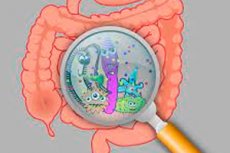Intestinal microbiome affects blood pressure
Last reviewed: 07.06.2024

All iLive content is medically reviewed or fact checked to ensure as much factual accuracy as possible.
We have strict sourcing guidelines and only link to reputable media sites, academic research institutions and, whenever possible, medically peer reviewed studies. Note that the numbers in parentheses ([1], [2], etc.) are clickable links to these studies.
If you feel that any of our content is inaccurate, out-of-date, or otherwise questionable, please select it and press Ctrl + Enter.

Probiotics can lower blood pressure by tidying up the intestinal microflora and thereby regulating metabolic processes. The work by researchers from the University of Hong Kong and Inner Mongolia University of Agriculture was recently published in the journal mSystems.
High blood pressure is a problem for just under half of the world's adult population. Hypertension often leads to the development of cardiovascular pathologies, sometimes becoming the cause of death. Previously, there were a number of studies that demonstrated an increase in the incidence of hypertension on the background of increasing consumption of sugars, including fructose, which is considered the basis of many diets. It has been scientifically proven that regular consumption of fructose can increase the risk of hypertension, for example, by causing insulin resistance, salt retention in tissues, and decreased production of nitric oxide in the kidneys. Scientists have also analyzed the possible effect of sugar on the quality of intestinal flora.
In their recent work, researchers studied in rodents the hypotensive effects of selected probiotics, isolated from women's milk. The probiotics in question were Bifidobacterium lactis and Lactobacillus rhamnosus. The participating rodents were divided into four groups. The first group was offered plain water to drink. The second group was offered water with added fructose. The third group received fructose-rich water with Bifidobacterium lactis, and the fourth group received water with fructose and Lactobacillus rhamnosus.
Blood pressure values in rodents were measured at the start of the project, and then at the fourth, tenth and sixteenth week. The addition of fructose to the water caused a marked increase in blood pressure in the animals, compared to the group whose participants drank plain water. After sixteen weeks of drinking water with bifidobacteria and lactobacilli, the average systolic blood pressure in the rodents decreased by almost 17% and 15%, respectively, and diastolic blood pressure by 19% and 20%.
In the next step, the researchers performed metagenomic sequencing to determine the relationship between the quality of gut microflora marshaled by probiotics and lower blood pressure. The work demonstrated that the group of animals taking fructose had an increase in Bacteroides microorganisms and a drop in Firmicutes. In the groups receiving probiotics, the level of Bacteroides recovered to almost the original value.
Taking into account the data obtained, experts made an important conclusion: probiotics are able to correct high blood pressure, change the quality of microflora, inhibiting the spread of pathogenic microorganisms, and restoring the growth of beneficial bacteria.
For information, see source page
